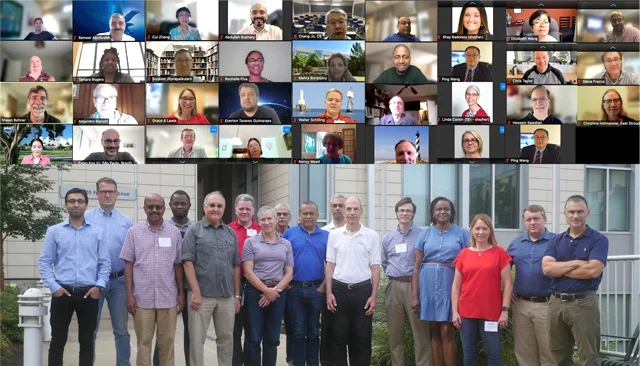Software Engineering Educators Gather at Hybrid Workshop

• Article
September 6, 2022—The 19th Software Engineering Workshop for Educators wrapped up earlier this month. Sixty-four college-level educators met in person and online August 2-4 to swap teaching techniques and artifacts. Researchers from the Software Engineering Institute and academia also taught sessions on modern software engineering topics.
Forrest Shull, the SEI’s lead for defense software acquisition policy research, opened the workshop by summarizing the SEI’s National Agenda for Software Engineering. This research roadmap reimagines the discipline of software engineering and identifies the technologies and research areas that are most critical for enabling future systems.
Robert Nord, a senior member of the SEI technical staff and one of the workshop’s facilitators, updated attendees on the SEI’s work in technical debt, a topic often covered in software engineering curricula.
In the workshop’s third session, Christian Kästner, of Carnegie Mellon University, discussed how to integrate software engineering and data science. Experts in these two fields often have different goals, processes, and expectations, which Kästner said could work together better with a system-centric view.
The second day of the workshop opened with a talk on software engineering challenges and opportunities in edge computing. SEI engineers Marc Novakouski and Kevin Pitstick discussed typical edge computing uses cases, benefits, and challenges to computing resources, network connectivity, privacy, and security.
Carnegie Mellon University’s Eunsuk Kang followed up with a session on the teaching of software design, a field often considered more art than science. Kang shared the elements and activities of his software design curriculum. The talk generated a lively discussion on why students need experience with real-world software projects.
Workshop participant Nayda Santiago of the University of Puerto Rico plans to take lessons from the edge computing and software design sessions back to the classroom. “The formality given at the workshop is definitely something I will incorporate in the course,” said Santiago. “Both of these topics, and the debates generated in the meeting, allowed me to identify aspects of the capstone project course that I can modify.”
The final day of the event began with breakout sessions where the educators discussed the challenges of teaching in the COVID-19 environment. “As we are emerging from the pandemic, most universities are returning to in-person instruction. But most will continue to offer virtual and hybrid courses to reach a larger number of students,” said Grace Lewis, an SEI principal researcher, lead of the Tactical and AI-Enabled Systems (TAS) initiative, and workshop facilitator. “Our participants were particularly concerned about assessment, student engagement, hybrid and mixed-mode teaching, and technologies. It is clear that virtual and hybrid teaching remains challenging for both instructors and students.”
The most anticipated part of every year’s Software Engineering Workshop for Educators is the artifact-sharing session, in which attendees trade tools and techniques from their curricula. This year, participants shared many different types of artifacts, including puzzles and games on incremental software development, an Internet of Things assignment, a tabletop attack-defense lab, slides on DevOps, and tips on professionalism in the classroom.
“I always discuss and reference SEI architecture-centric practices in my enterprise integration courses and have some more updated content to include from the artifact sharing,” said John Landmesser of Penn State Brandywine. “I also intend to include some of the problem-based activities into various courses, and I found [the] group tabletop security exercise a very useful activity for my information security management course.”
Participants hailed from 16 different countries in Asia, Europe, South America, and North America. “It was interesting to see that although we are from very different institutions, some of our issues are common, and my colleagues have developed some very creative and inspiring approaches to addressing them,” said Rochelle Elva of Rollins College.
SEI Fellow Nancy Mead, also of Carnegie Mellon University, pointed out that some workshop attendees teach not just students, but other educators. “There were a number of attendees who have been involved in software engineering curriculum design,” said Mead. “They have also been organizers of education conferences and pioneers in offering software engineering degrees.”
“The overall experience was entirely positive and beneficial in multiple ways,” said Simanta Mitra of Iowa State University. “Aside from opening my mind and knowledge of different topics, the workshop also introduced me to a large number of educators, many of whom I plan to keep in touch and collaborate [with].”
While the in-person experience was important for attendees, the remote attendance option enabled many people to participate. “A webinar format would have met the demands for accommodating a larger hybrid audience. However, we would have lost the spirit of the collaborative event, where we traditionally have lots of participation,” said Nord. “We decided to take a chance and host the workshop using a meetings format. This worked well as most educators had experience with this format. It allowed remote participants to turn on their video and audio, see who else was in attendance, and interact with the instructors and each other. Breakout sessions provided small-group interaction for all attendees.”
The hybrid format is already part of plans for next year’s workshop, the event’s 20th anniversary.
Learn more about the Software Engineering Workshop for Educators on our website.

